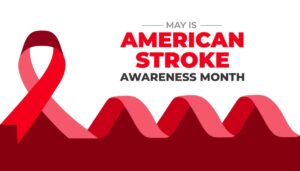
Learn the warning signs Stroke is an emergency. If someone is having a stroke, they must get medical attention right away.
Use the acronym F.A.S.T. to identify the most common signs of stroke:
Face Drooping – Does one side of the face droop or is it numb? Ask the person to smile. Is the person’s smile uneven?
Arm Weakness – Is one arm weak or numb? Ask the person to raise both arms. Does one arm drift downward?
Speech Difficulty – Is speech slurred or hard to understand? Ask the person to repeat a simple sentence, like “The sky is blue.”
Time to Call 911 – If you notice any of these symptoms, even if they go away, call 911 and get to a hospital immediately. Quick action can save a life.
A large majority of strokes can be prevented:
Manage your blood pressure – Lowering your blood pressure reduces your risk of stroke. According to the 2025 American Heart Association Statistical Update, nearly half of adults in the U.S. have high blood pressure, and many don’t even know it.
Live a healthy lifestyle – Eating well, staying active, quitting smoking and managing stress can all help lower your stroke risk. The Association’s Life’s Essential 8 provides key steps for improving and maintaining cardiovascular and brain health.
Monitor health conditions – Conditions like atrial fibrillation (AFib), diabetes and high cholesterol increase stroke risk. Work with your health care provider to manage them.
Reduce risk for a second stroke -Nearly 1 in 4 survivors will have another stroke, in some instances because they don’t know what caused the first stroke. Testing to identify cause and additional risk factors can help you and your health care team develop a plan to prevent another one.
Those who have had a stroke often must work against physical, emotional and cognitive changes to move forward. Stroke survivors and caregivers can track their health journey, medications and receive trusted information about stroke with the Heart & Stroke Helper app.
Learn more at Stroke.org/StrokeMonth. The HCA Healthcare Foundation is a national sponsor of the American Stroke Association’s Together to End Stroke® initiative and American Stroke Month.
